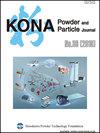不同产地高岭土的性能及其对浇注率的影响
IF 3.2
4区 材料科学
Q3 ENGINEERING, CHEMICAL
引用次数: 2
摘要
众所周知,来自不同地点和产地的矿物样品在其性质和行为上可以表现出显著的变化。目前对三种高岭土样品的研究,从沉积物的起源、组成和陶瓷性能等方面进行了广泛的研究,为研究矿物学、化学组成、颗粒形态和表面性能与其在陶瓷应用中的流变行为(如铸造速率)之间的相互关系提供了重要的,也许是独特的机会。高岭土样品#2和#3的x射线衍射图显示结晶度较低,欣克利指数(Hinckley Index, HI)在0.78 ~ 0.8之间。另一方面,高岭土1号样品有序度高,HI约为1.21,石英含量较高。游离石英可以提高透气性,从而提高浇注速度。样品#2和#3中丰富的二价离子(ca2 +和mg2 +)可能导致双电层坍塌和zeta电位降低,因此,颗粒的凝固导致粘度和分散剂需求的增加。形态学研究表明,样品#2和#3中的血小板颗粒会导致脱水较慢,因此铸造速率低于样品#1中的块状颗粒(宽高比较低,尺寸分布较窄)。本文章由计算机程序翻译,如有差异,请以英文原文为准。
The Properties of Kaolin from Different Locations and Their Impact on Casting Rate
It has been well known that mineral samples from different locations and origins can exhibit a significant shift in their properties and behavior. The present study of three samples of kaolin from a wide set of origin of deposits, composition, and ceramic properties, provided an important and perhaps a unique opportunity for investigating the interdependence of mineralogy, chemical composition, particle morphology, and surface property with their rheological behavior in ceramic applications such as casting rate. The X-ray diffraction patterns of kaolin samples #2 and #3 suggested low crystallinity with Hinckley Index (HI) ranging between 0.78 and 0.8. On the other hand, kaolin sample #1 was highly ordered with HI of about 1.21, and it had higher quartz content. This free quartz could enhance the permeability and hence increase the casting rate. The abundance of divalent ions (Ca 2+ and Mg 2+ ) in samples #2 & #3 could result in the collapse of the electrical double layer and reduction of zeta potential, consequently, coagulation of the particles leading to an increase of viscosity and dispersant demands. The morphology study suggested the platelet particles in samples #2 & #3 would lead to slower dewatering, thus, lower casting rate than that of the blocky (lower aspect ratio and narrower size distribution) particles in sample #1.
求助全文
通过发布文献求助,成功后即可免费获取论文全文。
去求助
来源期刊

KONA Powder and Particle Journal
工程技术-材料科学:综合
CiteScore
8.40
自引率
4.90%
发文量
35
审稿时长
>12 weeks
期刊介绍:
KONA publishes papers in the broad field of powder science and technology, ranging from fundamental principles to practical applications. Papers describing technological experience and critical reviews of existing knowledge in special areas are also welcome.
 求助内容:
求助内容: 应助结果提醒方式:
应助结果提醒方式:


